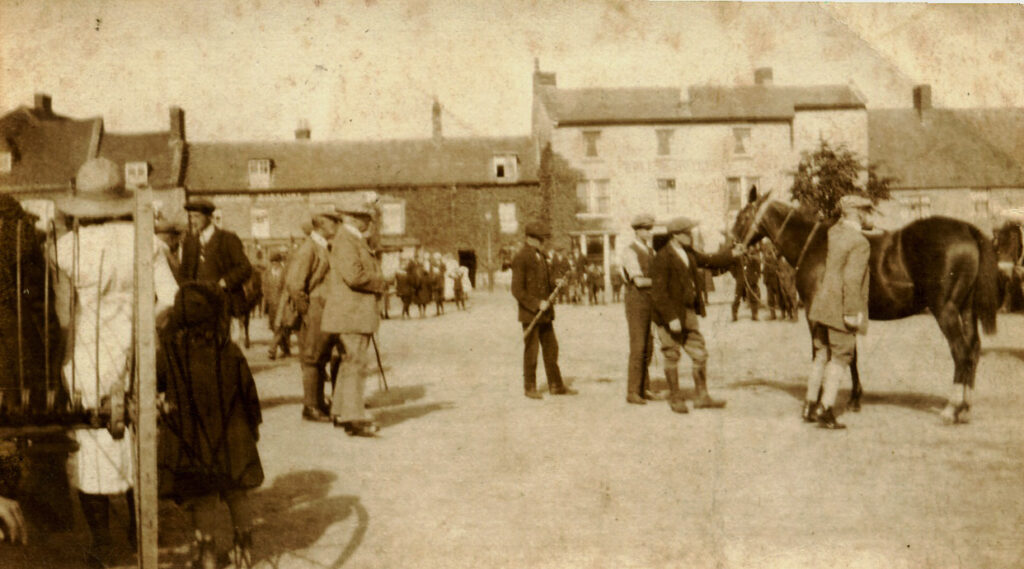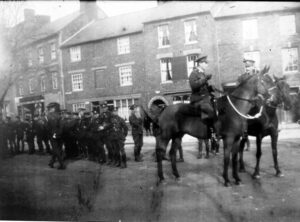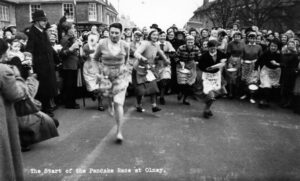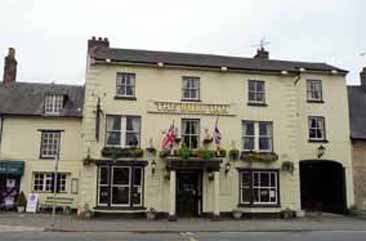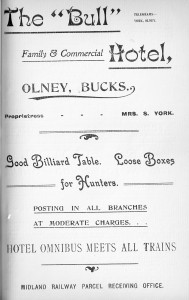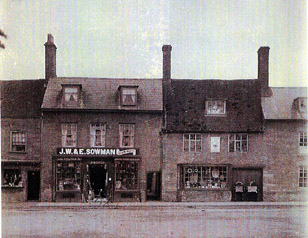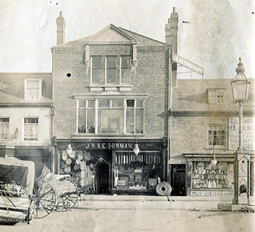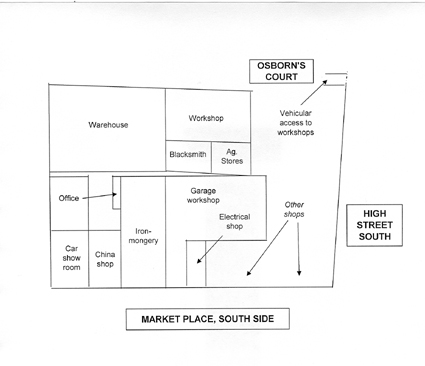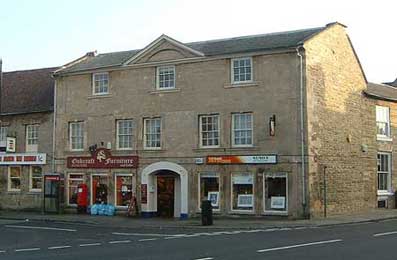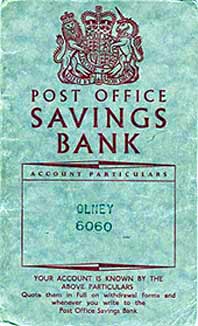.
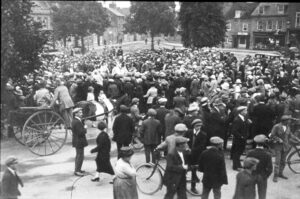
.
Click the ‘Welcome’ heading to start the trail.
This audio trail presents a ‘light’ introduction to the history of Olney Market Place and mainly covers the period from around 1800 to ‘more recent times’. It is divided into three sections addressing the Market Place and a further seven sections covering a selection of the surrounding buildings and their residents.

Centenary celebrations of John Newton held on April 25 1907
Note the Town Pump with the Lamp mounted on it.
Although this trail can be viewed without even venturing out of your home, we would suggest that a ‘live’ visit to Olney Market Place will provide an enhanced experience.
If you do choose the ‘live’ visit option using your smartphone, please allow around 30 to 45 minutes for this purpose. You may find it an advantage to have a pair of earphones about your person to deal with any occasional excessive traffic noise from the main road!
As no phone ‘data usage’ costings have not undertaken it would be advisable if you are on a ‘pay as you go’ tariff to check your spend periodically.
Please note that this trail is not strictly a walking trail, since it only requires the user to move a few metres occasionally to reposition themselves on the Market Place such that they have an adequate view of the subject or section being addressed. Consequently this trail could be considered as ideal for people with limited mobilility, or of course those who would simply like to be entertained whilst sitting on one of the public benches strategically placed around the Market Place!
The start to each section is highlighted as a ‘Bold Title’. Simply click a ‘Bold Title’ to reveal the text and images for that section. (Click the ‘Bold Title’ again to hide the text and images for that section.)
Next, click the audio bar for the voiceover and click a second time to mute it.
Click any image for an enlarged view.
.

.
The Market Place – the reason for Olney’s status as a town – has always been the hub and centre of its life. Olney does not have a Market Charter, instead it has a ‘prescriptive’ market, one founded on ancient custom and viewed as an authoritative claim established by long use. A weekly market has been held on this Market Place since at least 1206 and two fairs held annually, the Cherry Fair in June and the Statute Fair in October.
The Cherry Fair coincided with the Church’s Patronal Festival. Holy Days and were the only ‘holidays’ workers had, so a licence was granted to the Lord of the Manor in 1316 to hold a Cherry Fair ‘for the vigil, feast and morrow of St. Peter and St. Paul’. It was designated a ‘Cherry Fair’ so that the fruit from the many orchards around medieval Olney could be sold off quickly. The Fair was originally held on the Market Place and later when it had primarily developed into a funfair it moved to the ‘Fair Field’ off East Street, now a residential street named Fairfield Close.
Incidentally the bi-annual funfairs returned to the Market place after WW2, but some years later again moved to East Street and sited on ‘Olney’s Football Ground’ formally known as the ‘Nursery field’ or ‘Recreation Ground’.
The Statute Fair in October was probably the usual autumn hiring fair held in country districts when workers could put themselves up for hire. Prospective employers, each distinguished by a badge of office worn in his cap, came to view the various workers either on the Market Place or at an Inn, such as the Bull.
Moving forward a few centuries to the 18th century, the Kettering and Wellingborough to London Turnpike road ran along the western side of the Market Place while the southern side was known as ‘The Parade’.
The sketch dated 1860 is attributed to Walter Pennington Storer a local schoolmaster. This sketch appears to be the only visual evidence of a row of ‘untidy commercial buildings’ which ran from the Round House or Lock Up (Stone House on the sketch) to opposite the ‘poet’s house’ (Orchardside) on the eastern side of the Market Place. The buildings included a yard belonging to Lawrence Spencer, a butcher, also a pub (the Horse and Jockey) belonging to John Bent. On the southern side of Sheil Hall a Mr Paybody was operating a blacksmith’s forge. The annotations at the bottom of the sketch referring to the buildings on the west side of the Market Place are believed to be Hollingsheads, Wilson the barber, The Saracen’s Head and the Bull Hotel.
A well known Market Place image of that period has been added to assist the identification of the buildings on the sketch.

The Market Place c.1810 showing the Lock Up to the left and the Sheil Hall to the right of the image
It is possible of course that some of those untidy commercial buildings might have been removed from the Market Place before 1860. Obviously all the ‘commercial buildings’ were eventually removed. Or perhaps, dare one suggest, that the sketch was a W P Storer hoax!?
Olney’s market was held each Monday, but during the second half of the 19th century it fell into decline. Later the market was held fortnightly on Thursdays, and the Cattle Market revived and held again on Mondays. The general market today is still held on Thursdays, but the last cattle market was held in April 1987 and the last Fat Stock Show took place in 1986.
Originally the Lord of the Manor received the rents from the Market, but when part of Olney Court Estate was sold in 1941, Lot 6, entitled ‘Manorial Rights of Fair and Market belonging to the Manor of Olney’ was acquired by the then Olney Parish Council.
Concerts and meetings continued, and still continue to some degree, to be held on the Market Place, being the traditional gathering place and focus for Olney townsfolk. The 1949 British Legion Fete parade and subsequent parades, including the later very popular annual Floral Fiesta parades, incorporated the Market Place into their town tour.
In the 1940s, Tom Garner, a successful draper trading and residing on the eastern side of the Market Place, left a thousand pounds in his will towards the resurfacing of the Market Place, which was completed in the early 1960’s. This improvement was the salvation of the modern market, resurrecting it from two stalls to, often, a full list of traders pitching a stall on Olney’s Thursday Market.
Today, the Thursday Market remains well attended and relatively stable in terms of the number of stalls and the variety of produce and goods available. In addition, a Sunday Farmer’s Market held on the first Sunday in each month, also appears to be stable and doing brisk business.

After re-surfacing with tarmac the Market Place, the market began to re-establish itself in the 1960s
Also it needs to be acknowledged that the Market Place currently fulfils the important role of a very convenient, but somewhat inadequate, car park for most of the week and it is difficult to envisage a time when it will be able to relinquish this role.
.

Olney’s triangular Market Place (sometimes erroneously called ‘Square’) was levelled and gravelled around 1780, thanks to the generosity of Daniel Raban, a baker. William Cowper, the poet who lived for 19 years in a house overlooking the Market Place records the resurfacing in one of his letters to John Newton dated February 1782.
‘Daniel Raban (baker) has levelled and gravelled the Market Hill, and because water is scarce at Olney, has put the parish to the expense of a town pump, and designs, in order that people may not run their heads against it in the night, to crown it with a lamp. As the people here are not so rich as to be able to afford superfluities, this measure does not give universal satisfaction. I subjoin the only verses I have written for some time, which, however, are not to be published. The pump stands opposite Banister’s door.’
‘Let Banister now lend his aid
to furnish shoes for the Baker,
Who has put down a pump,
with a lamp on its head,
For the use of the said Shoe-maker.’

The Market Place c.1810 showing the Lock Up to the left and the Sheil Hall to the right. (duplicate image)
At the beginning of the 19th century there were three significant buildings on the Market Place itself. The above quoted letter to John Newton gives the history of one – the Parish Pump – which survived into the 1960’s but was removed when the Market Place was resurfaced again. The pump is now in the Cowper & Newton Museum yard.
Another feature was the Shiel Hall, a two storied building, the upper part of which was reached at the northern end, by a double flight of steps. A blacksmith’s forge occupied the southern end. The building was used as a ‘town hall’ and a school, which was run by the eccentric Samuel Teedon.
To the east of the Shiel Hall was the third significant building, the Round House or Lock Up, a small hexagonal building. The Round House was taken down about 1846 and re-erected for a short time further down the High Street. All that remains today is the stone ball that topped it, which is now also in the Cowper & Newton Museum yard.
A couple of interesting sketches follow of the Market Place in William Cowper’s and John Newton’s era.
.
.
.

.
Originally there were three elm trees on the Market Place, said to commemorate the union of the three kingdoms England, Scotland and Ireland in the reign of James I. Under the trees stood the stocks. One tree disappeared before 1800, another was blown down about 1832, and the third was damaged by a bad storm on 4 July 1884 but recovered and continued to flourish until around the end of the 1940s. Seven Linden trees were planted around the Market Place during the late 1800s to compensate for the eventual demise of the third elm tree.

The Market Place c.1890
noting the status of the Elm tree and the Linden trees (and the lack of any vehicular traffic!)
.
As with all small towns in England, Olney residents were deeply affected by World War I. An indication of the impact of the war is recorded in Mr Joe Garners Diaries for this period. (Link to the diaries on this website) Two images are included showing mounted servicemen and soldiers during WW1 conducting training or recruiting exercises on Olney Market Place.
.

Soldiers engaged in training exercises outside Paggett’s shop in Olney Market Place during WW1 – Image 2
.
The War Memorial
The War Memorial sited towards the north of the Market Place was erected in the form of a cenotaph and commemorates the 64 men from Olney who died in Service during the First World War and the 19 men who died in Service during the Second World War. The memorial was unveiled on Sunday, 1st May 1922 by General Lord Horne of Stirkoke. The two images show this event.
.
.
.
The Olney Pancake Race
The story of Olney Pancake Race on Shrove Tuesday began around 1445. In those days the custom was for housewives to use up excess fats by cooking pancakes and to take them to the church as an offering and symbol of sacrifice for Lent. This custom was prevalent in many regions of England. Today, many people still give up something for Lent, usually a luxury such as chocolate, or alternatively take on a charitable task during Lent.
One year, so the legend goes, a young woman from Olney, who had just finished making her pancakes heard the sound of the parish church bell tolling, signifying that the shriving service was about to begin. Harassed by the bell, she stopped everything she was doing, picked up her frying pan complete with pancake, and ran to the church. And so, from this legend the Pancake Race was born!
The Shrove Tuesday event in Olney was revived in 1948. The rules state that the competitors must wear headscarves and aprons, and must assemble on the Market Place before 11.55am, complete with frying pan and pancake.
The photograph captures the scene at the start of the annual Olney Pancake Race in 1956. In that year the race was won by Cicely Sparrow.
Today the Olney Pancake Race still takes place annually but the course of the race has now changed a little from the original route. It used to start at the old Town Pump on the Market Place and finish close to the main door of the church. The current route begins outside the Bull Hotel and finishes near to the small side gate to the church in Church Street. The final leg up the churchyard was abandoned in the early 1950s. The distance remains unchanged at 415 yards.
In 1950 the race became an annual international event. Olney accepted a challenge from the town of Liberal in Kansas USA to compete in an identical race. Since that year the race wins have been shared broadly equally between the two towns. This annual international event continues….
(Acknowledgements are due to Graham Lenton for his book ‘The story of the Olney Pancake Race’ published by ‘gml art’ in 2003 which has been perused in support of the above summary.)
.
The Bus Shelter
During the 1950s a very functional, but not particularly aesthetically pleasing brick built bus shelter and toilet block, was erected opposite the Bull Hotel. But, on the other hand for some years years now, some very attractive flower beds have been meticulously maintained by Olney Town Council staff on either side of the bus shelter. These flower beds coupled with the ‘Olney’ sign, several tasteful benches and other pleasing accessories suitably positioned on the Market Place do much to ensure that Olney retains its abiding image as an ‘attractive town in which to live’.
.
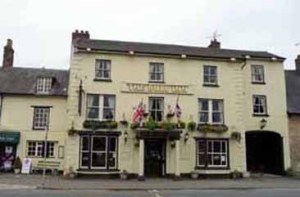
No. 8 Market Place, The Bull Hotel (2012)
.
THE TRAIL CONTINUES BY COMMENTING ON A SELECTION OF THE BUILDINGS AND THEIR RESIDENTS SURROUNDING THE MARKET PLACE.
.

.
Owners of the drapery business
Daniel and Hannah Clarabut established a drapery and millinery business at No 5 Market Place in 1837, when Daniel would have been only in his early 20’s. When Daniel died in 1880, William Clarabut took over the business and subsequently purchased Number 6. In 1910 William Clarabut is recorded as the owner/occupier and local advertising at that time indicated that drapery was undertaken in Number 5 and tailoring in Number 6. William was also listed as a Funeral Director.
It would appear from the 1911 Census that Charles Mortimer Allen, aged 34, had taken over the business. Charles lived on the premises with his family, together with a dressmaker and an assistant. The business became known as ‘Allens of Olney’ and still retains that name today.
During the mid 1950s the Allen’s retired to ‘Hawthorns’ at 93 Weston Road and Leslie Fairey and his wife Joan acquired the business. Les had first worked for Charles Allen in the 1930s as an apprentice. After a spell away at Braintree in Essex to broaden his experience (where he met his wife Joan), Les returned as tailor and draper. The Fairey’s progressively and successfully developed the business at Nos 5 and 6 over the decades until Les died in 1998.
The business is now owned by Les and Joan’s daughter, Jane Cox, who again has developed the business in conjunction with Ashley Pankhurst.
Allen’s sales and fashion shows
In the 1950s Allen’s shop was particularly popular around ‘sale’ times when queues formed outside the shop long before opening time. It was reported that in one year during this period the New Year Sale’s queue stretched back to the entrance of the Bull Hotel. Sadly the photographic evidence of this queue has long since been misplaced.
Allen’s ran Fashion Shows, usually in the Church Hall, every six months in advance of the spring and autumn seasons. The line of ladies in the photograph of an Allen’s Fashion Show in the 1960s, are from left to right: Dorothy Penfold, Sally Ryder, Betty Pibworth, Mildred Wickens, Olive Norton, Mary Wright, Glenys Davis and Linda Pettit.
Leslie Fairy as ‘local councillor extraordinaire’
Leslie Fairey was equally well known for his service to public life. Les was approached in 1947 to consider joining the Olney Parish Council, which he accepted and was co-opted in 1947. Eventually he became Chairman, a position he held and enjoyed for some 21 years, particularly since he topped, or nearly topped, the poll over these years.
Later Les also served on Newport Pagnell Rural District Council for over 12 years. This council was displaced by the creation of Milton Keynes Borough Council, formed when Milton Keynes was in its infancy. Les put himself up for election, won a seat and became the representative for Olney. He served Olney in this role for over 3 years. His role was primarily to maintain a balance between the needs of Olney and Milton Keynes and to ensure that the needs of Olney were voiced in council. Les also became the first Honorary Alderman to be appointed for Milton Keynes.
.
An opportunity follows to listen to Leslie Fairey in two audio recordings. In the first, Les tells how he became employed in the drapery business working under Charles Mortimer Allen. In the second, Les tells how he became involved with Olney Parish Council, Newport Pagnell Rural District Council and Milton Keynes Borough Council.
.
In the first, Les tells how he became employed in the drapery business
.
In the second, Les tells how he became involved with local councils.
.
It is believed that these two audio interviews may have been recorded by BBC 3CR. Should this be the case then of course acknowledgements are due to the BBC for these informative recordings.
.

.
.
Around 1850, William Hipwell came to Olney from Newport Pagnell with the idea of starting a brewery. He was then landlord of the No 8 Market Place The Bull Hotel. In 1853, along with Charles and John Coling, William bought a piece of freehold land to the west of his premises ‘being parcel of Cherry Orchard or Bull Orchard’ from Thomas Welton.
A month later Thomas Charles Higgins, owner of th Saracen’s Head next door, granted them a right of way for access to the proposed site. This was the 12 ft wide lane between his property and the side entrance to the Baptist Chapel, formerly known as Bear Lane. Water for the brewery was drawn from a well in a field called ‘Clumps’ at the top of Spring Lane.
William Hipwell then ‘set about’ buying several Olney public houses owned by the Lord family during the 1860s and 1870s. By the time of William Hipwell’s death in October 1882, Hipwells owned all the public housess in Olney except for The Castle. In 1921 the business was sold to Phipps brewery of Northampton and in 1949 Stanley Woods, furniture manufactorer, acquired the brewery property.
The Bull Hotel was once an important coaching inn. It was a stopping place for the ‘Beehive Coach’ which ran between Wellingborough and London during the mid nineteeth century. The complete 70 mile journey took some 9 hours to complete. Other coach companies also ran the Wellingborough to London route via The Bull Hotel at Olney.
An abbreviated version of the timetable for the London to Wellingborough stagecoach is added for your interest.
LONDON – WELLINGBOROUGH
London (George & Blue Boar, Holborn), Barnet, St Albans, Dunstable, Woburn, Newport
Pagnell, Olney, Wellingborough
Distance 70 miles. Journey time 9 hours
Depart London at 8.00am, Mon, Wed, Fri, Wellingborough at 8.00am mon, Wed, Fri
4 seats inside, 8 outside
Operator Benjamin Worthy Horne & Co Numbers 3549
.
When the rail passenger service from Northampton to Bedford was opened in 1872 , the journey time from Olney to London was reduced to a little over 2 hours.
Moreover, a ‘Station Conveyance’ ran from the Bull Hotel to the Station to meet every train. The probable ‘Station Conveyance’ or ‘Hotel Omnibus’ is shown outside the Bull Hotel in the coloured image.
The Bull Hotel was also used as a meeting place for Dinners and Auctions. The Inland Revenue even had an office here in 1883!
Landlords for the Bull Hotel during the period period of 1800 – 1940 can be found listed using the following link to The Bull Hotel.
The 1910 Inland Revenue Survey records Hipwell & Co. as the owner and confirms S. York as the tenant; the 1911 Census also cites Susannah York as the Hotel Manager. An advertisement is included for the Bull Hotel that appeared in Ratcliff’s 1907 ‘Olney, Bucks’ Almanack.
Three images of the Bull Hotel through the generations are added for your interest:
.
.
.
.
For much of the later twentieth century the business at the Bull tended to operate as a public house rather than as a hotel. The ownership changed to Charles Wells during this period. The Bull did have a function room which was primarily used for masonic purposes but was also used for all kinds of social activities such as dances and specialist sales. In the early 21st century, like many businesses of its type, it did appear to suffer from a lack of investment, but it did become the first home of a successful Olney Jazz Club. After this relatively quiet period the whole site underwent a major modernisation and refurbishment programme in 2017/8. which has provided an excellent basis for its future regeneration.
.
Number 9 Market Place was the customary alehouse sited next to a coaching inn, and was known as the Saracen’s Head.
The 1891 Census confirms that Richard Sanders was the landlord in that year. He was also the driver of the Conveyance that met all the trains at the Station and brought passengers back to the Bull Hotel.
It is believed that the Saracens Head closed as a public house well before the start of WW2, but the building still remains part of the Bull Hotel complex.
.

.
At the beginning of the nineteenth century this building on the corner of the Market Place was lived in by a Mr Soul. Previously it was once occupied by the Minister of the Baptist church, the Reverend John Sutcliff, before his marriage.
William Andrews was the owner of the property at the time of the second and third levies (1810 and 1833). A young maltster, Alfred Brooks, occupied the property in 1841. By the time of the 1851 Census, Thomas Welton, a Reverend gentleman of 65 years described himself as ‘a Clerk without a cure of Souls’. He lived there with his young wife Elizabeth (aged 33 years) together with a cook and a housemaid.
Hipwells, the local Brewers, owned the property towards the end of the nineteenth century. Probably William and Sarah Hipwell and their children moved into Westlands in 1866 when they vacated the Bull Hotel. The 1891 Census lists Sarah Hipwell, three daughters, a son and a granddaughter living at Westlands, William died in October 1882.
Some years earlier William Hipwell had given £500 for the shop and house at No 12 Market Place and then demolished them. He wished to build a gable annex to his house and have a garden wall sweeping around it. In the late 1930’s, the garden area to the south of the property was donated to the Baptist church so that a front entrance to the church could be constructed facing the Market Place.
The 1910 Inland Revenue Survey places this property in the High Street, rather than on the Market Place, and suggests that Sarah Hipwell was the owner/occupier of Westlands. The 1911 Census also records a High Street address with Sarah (aged 86), her son Samuel Edgar and daughter Florence May residing there. The 1936 Register of Electors lists Florence May Hipwell and Samuel Edgar Hipwell living at Westlands, along with three other residents. The 1951 Register of Electors lists Henry Charles Pugh and Frederica Pugh living at Westlands.
For many years during the late twentieth century and the early years of this century, the house was extensively converted into a residential home and served a much needed role in this capacity.
In recent years the property was purchased by Oakman Inns who extensively extended and refurbished the property during 2017/8. It is now known as the Cherry Tree Pub & Restaurant. The building has been restored to feature its old Victorian and Georgian features, such as corniching, plaster work, sash windows, parquet flooring and fire places.
.

Garner’s was an extensive drapery shop situated on the eastern side of the Market Place at Numbers 21 and 22. The business was founded by Joseph James Garner on 28th August 1886 and finally closed its doors in 1972. Mr Garner (he was always known as Mr Garner) was an ambitious, diligent and particularly hard working draper. He died in 1944 at the age of 77.
The first image shows Mr Garner outside the door of his newly opened shop in 1886. Mr Garner lived above the shop in Number 21. His parents and brother are standing in the doorway of their home at Number 22. The children appear to be dressed in their ‘Sunday Best’.
During the first half of the twentieth century, Garner’s was one of four particularly large shops in Olney; Garners Nos 20, 21 and 22 on the east side of the Market Place, J W & E Sowman the ironmongers formerly on the south side of the Market place Nos. 32 – 34, Allens the outfitters which still trades on the west side of the Market Place Nos. 5 & 6, and the Co-operative grocery store formerly on the east side of the High Street at Nos 16 & 18.
Joseph Garner carried on business in Olney for over 50 years, first as a draper, before he added outfitting, and finally a furnishing department. He often commented that Garners possessed the longest shopfront in the town. By 1937 the premises at No 20 had been added to Mr J J Garner’s drapery business at Numbers 20A, 21 & 21A Market Place. The Garner business and living accommodation eventually spanned from Number 20 to 22 Market Place. Mr Garner had also bought No 23 a year earlier in 1936.

Joseph James Garner – 1937
He was proud of being a Bucks man. Born at Newport Pagnell, he was educated at the British School in that town. In 1877 he won one of the first scholarships which entitled him to free education for three years. In 1880 he went to work (probably as a ‘live-in’ apprentice) for Messrs AlIen & Vyle, drapers, in Buckingham and it is here that over a period of six years he had a good grounding in the trade of draper.
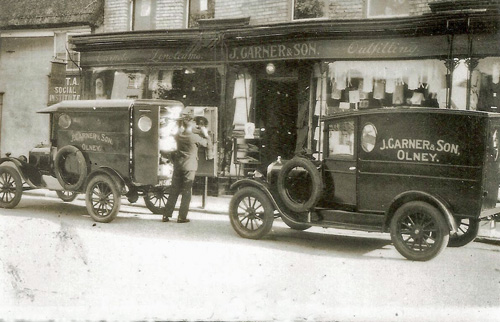
Morris and Ford delivery vans outside Garner’s shop – October 1931 (The Ford is on the left and the Morris on the right)
On August 28th 1886 he moved to his premises in the Market Place in Olney to be a business man on his own account. It was from here that he took a prominent part in the business affairs of the town and he derived much happiness in assisting in many ways the advancement of the town of his adoption. He often recalled that when he first came to Olney there was no Midland Road, no large factory at the corner, the streets were only paved in patches – cobble stones predominated – there were no sanitary arrangements, no water works, no electric light. In those days you had to mount stiles and cross fields to get to the railway station, and much of the shoe work was done by cobblers in their own homes.
He was delighted to see Olney develop into an up-to-date country town with streets well cared for and tidy, the shops clean and bright, and the amenities of the old town vastly improved. He had a very happy relationship with his fellow traders and said “we are a very happy family, and we work together amicably and smoothly”.
Number 22 Market Place has always been a private residence, and presumably was originally a perfectly proportioned house. The shop frontage was added and became part of Number 21. As a private residence it is difficult to trace occupiers, but a young Church of England clergyman, William Pawnall and his wife and mother appear to have lived there in 1841.
The full history of Joseph Garner’s drapery business is described in a separate article on this website (see link).
.

.
This building, named Orchard Side, is of course, the ‘Cowper & Newton Museum’. The summary history of the building is reprinted from Oliver Ratcliff’s Olney, Bucks, originally printed in 1907.
‘When Cowper’s house was built is not on record. Curiously enough nothing is known of it prior to the arrival in it, in September 1767, of Cowper and his friend Mrs Unwin. The earliest preserved deed is a marriage settlement, made in 1769, when the property was conveyed to trustees for the use of the Rev George Smith of Market Street, who had married Mary, daughter of Robert Carey, a malster of Olney. In 1815 the house was sold by Mrs Smith to Mr Robert Andrews. In 1830 the Andrews family sold it to Mr James Hale Talbot. In 1854 it was sold by auction at the Bull Hotel – the purchaser being Mr WH Collingridge, who in 1900, presented it – To the town and nation -‘.

Mr W H Collingridge
The Museum, a large brick building with stone dressings, consists of two tenements. William Cowper and Mrs Unwin resided in the western one, and Dick Coleman (Cowper’s protégé) and his wife in the eastern one – hence the latter is sometimes called “Dick Coleman’s house”.
A series of five untitled images featuring the frontage of Orchard Side over the years is included for your interest.
.
.
Information on the features and activities of the Cowper & Newton Museum, its opening hours, etc., is to be found on its comprehensive website. See link:
.
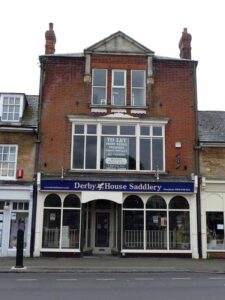
.
In 1888 two young brothers came to Olney from Colchester. They were John William and Edwin, the sons of William Sowman and Susannah (née Rudkin). Their father, a Solicitors’ Managing Clerk in Colchester, together with his sons, had purchased No. 32 Market Place (previously No. 33) from the owner, Mr Thomas Cooper and they planned to develop the existing ironmongery business into a much larger concern. Records indicate that there had been an ironmongery shop there since at least 1757 when Mr Joseph Palmer owned the business.
The Sowmans began trading in January 1889. The photograph was possibly taken during the first year of trading.
Expanding their business, Sowmans bought No. 33 in or around 1900. They demolished the building and built an extensive three storey property on the site. The new shop opened for trade on 27th June, 1904.
The following photograph shows the new shop front at No. 33 fitted with large plate glass windows, surely unusual at that time for a small rural town. Incidentally, the children in the foreground are known to be Sowman children; Ronald and John on the right and possibly Arthur and Philip on the left.
.
There is no doubt that the centrepiece of Sowmans business was the imposing three storey ironmongery shop, the front of which can still be seen on the south side of the Market Place. (No. 33 is now occupied by ‘Costa Coffee’.) Sowmans china shop was to the left of this building and to the right, the garage entrance and then the radio shop, all in all, a very large shop front. One of Sowmans sales slogans was “We sell everything from a tintack to a combine-harvester!” and another, “If you can think of it, Sowmans probably sell it!”
The name ‘Sowman’ was inlaid in mosaic on the porch floor in front of the main door of the ironmongery shop. This mosaic is clearly visible today. On opening the door, the air was redolent with the smell of dusty iron fittings, seed potatoes and other corn products indicating the agricultural nature of this rural town. On entering, a particularly long counter dominated the right hand side of the shop. Behind this counter the wall was covered with wooden drawers containing all manner of items for sale. At the far end of the counter was the staircase leading to the other two floors.
The ironmongery shop sold household goods such as saucepans, pudding basins, baking tins, cutlery, glassware, dusters, shoe polish, washing baskets, irons, kettles and thermos flasks. Miscellaneous items included pen knives, tennis racquets, cricket bats and balls, wallpaper (which had to be ordered from sample books), paint, fireplaces, Pedigree prams, shotgun cartridges, fishing rods and tackle, garden equipment, screwdrivers, hammers, saws, lawnmowers, calor gas heaters and toys, electric fires and hair dryers. Many of these things could also be repaired in the workshops at the rear. Sowman’s could supply the town with just about anything, including the kitchen sink!
In the 1950’s Sowmans employed around fifty people, including apprentices, and consequently had a significant influence on the wellbeing of the town, although the Tannery employed more workers and was probably the largest employer in Olney.
Sowmans pay and working conditions were generally average for the town, but with few benefits and no sick-pay scheme. Sowmans employees did not have to ‘clock in’.

Stanley Weetman Lord – 1933
Mr Stanley Weetman Lord, was appointed the General Manager of Sowman’s in January 1927 (according to Mr J J Garner’s diaries) and was undoubtedly the ‘boss’. After the Sowman brothers retired Mr Lord became the Managing Director. He lived at ‘Branksea’, 122 High Street, next to the former Brock’s Garage. He eventually became an Alderman and died in Olney in the 1960’s, shortly after his wife’s death.
In its later years Sowmans ironmongery shop was not always best known for its speedy service to its customers. There were too many little hidey-holes into which the shop sales staff could disappear, but the office girls always knew where to find them and winkled them out. In the 1950’s the whole enterprise was known colloquially as ‘Slowman’s’, so no one needed to be in a hurry when shopping there!
Nevertheless, the company was, in effect, both an emporium and an institution that served Olney and the surrounding area very well for more than seventy years. The atmosphere in Sowmans was invariably friendly and informal and staff morale was usually good. But then of course Superstores, Health and Safety Regulations (and Political Correctness) had not come along to change the way we shop, work and live!
When talks were in progress with Burgess’s of Stafford regarding a possible takeover, the staff were not kept informed. However the takeover did take place and the business did continue for several more years until it finally closed in 1984. Today, in spite of many changes, the original Sowman’s buildings still remain, but the 2007 photograph (below) shows how the shop fronts and traffic had changed up to that year!
.

.
Many of the larger houses in Olney were either rebuilt or refaced in the 18th century for relatively affluent lace dealers. Numbers 37 & 38, on a large corner plot, is an example. It was originally the Catherine Wheel Inn, but was virtually rebuilt and refaced for John Rickards in 1722 and remained a lace dealer’s premises for the next 100 years or more.
Numbers 37 and 38 Market Place became the home of the Talbot family, farmers, for many years. John Hale Talbot lived there through to the late 1840’s and Charles Hale Talbot lived there with his wife, four children and three servants in 1851.

Nos 35, 36, 37 & 38 Market Place 1930s
No 37 was Barclays Bank – The man on the left is Harrold Freeman
Thomas Freeman bought the premises in 1873 and lived and worked there with his sons as carpenters and building contractors. The 1936 Register of Electors lists Margueret Freeman living at Number 37, and lists Harrold (the third generation), Alma and Dorothy living at Number 38. Three generations of Freemans lived there in succession..It was subdivided at some later date into two separate shops; one being a china shop run by the female members of the Freeman family and the other half used by Barclays Bank.
In 1939 the left hand side of the building became Olney’s Post Office. Perhaps it is worth noting a few of the duties of staff working at the Post office during the 1940s and 50s.
The Post Office opened every morning at 9 o’clock, closed at lunch-time between one and two o’clock, and then closed for the day at six. On Saturdays, the staff had to stay on, often until seven o’clock, to balance the week’s takings. Wednesday was half-closing day, until it changed to Saturday in the mid-1950’s.
Very few people had bank accounts in the 1940s and 50s, so the Post Office acted as a bank for most of Olney’s population. Postal orders were issued and cashed (a sort of substitute for cheques). Radio , TV licences and Dog Licences were also iissued.
Old-age pensions and family allowances were paid out but only on specific days of the week. Family allowances were paid out on Tuesdays, old-age pensions were paid on Thursdays and Fridays. All these pensions were paid in cash for coupons in book form issued to qualifying individuals. For a long period, family allowance was not paid for the first child, only the second and subsequent children qualified!
Olney Post Office also operated the Post Office or National Savings Bank. Savings books were issued and money could be deposited or withdrawn at any Post Office in the country. The interest paid annually on these savings accounts was fixed for many years at two and a half per cent. The money saved was often used to fund holidays or Christmas presents. Saving stamps could be purchased for sixpence (two and a half pence) or half a crown – that is, two shillings and sixpence (twelve and a half pence). The stamps were stuck in a small book issued by the Post Office. Children were encouraged to use some of their pocket money to buy these stamps and so prompt them into the habit of saving money. These Saving stamps were also sold in schools.
Not only did the staff have to work in the post office, they were also expected to deliver telegrams. They often used their own bicycles to travel out as far as Warrington, Clifton Reynes and Emberton. Not many farms and houses had telephones then! At this time, the telegrams were often delivered by Gladys Johnson, who worked at the Post Office for many years. She was helped occasionally by Miss Boyes, a lady of real character, who was then at least in her sixties, and very keen to help, reputedly because some of the farms where she delivered telegrams gave her eggs which she took home in the basket of her very old ‘sit up and beg’ bicycle.
In the 1950’s a member of the Post Office staff was also required to go to Barclays Bank to collect the money to pay the pensions and allowances, and then walk back to the post office, unescorted, carrying about two thousand pounds in cash! Once within the Post Office, this money was kept in a small till out of view!
Since 1980 the Post Office has been located within McColls (formerly Forbuoys) newsagents, at the back of the shop on the east side of the Market Place.
.

Further information on all ten headings addressed in this trail, and on many other aspects of Olney’s history, can be found on Olney & District History Society’s extensive website.
On behalf of the Olney & District History Society and the Cowper & Newton Museum, we trust that you have enjoyed this Olney Market Place trail.
You will have undoubtably noticed that the Market Place is conveniently situated within a dozen or so restaurants and coffee shops. So before leaving for home, why not make your selection and enjoy?!
If you have not had an opportunity to visit the Cowper & Newton Museum on this occasion, then please consider a visit to this amazing heritage attraction in Olney in the near future.
.
The ODHS is indebted to Amy Botes for offering to provide and completing the full set of voiceovers for this Olney Market Place – Heritage Trail (Smartphone/Audio 2021 Version).
.
April 2021
(Amended September 2022)
Copyright © 2021 Olney & District Historical Society
.




